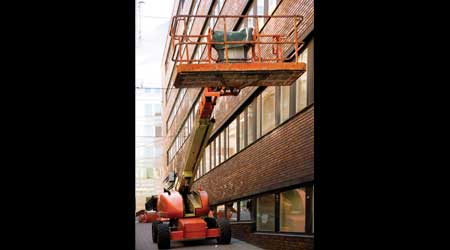Rent or Buy? Making a Smart Decision on MEWPs
Department needs and equipment costs are key considerations for managers looking to replace an existing lift.
Lifts — now commonly called mobile elevating work platforms (MEWP) — have become essential tools in many institutional and commercial facilities with tough-to-reach equipment and areas, such as gymnasium and auditorium lighting and exterior facades. Given the range of applications that front-line technicians can use MEWPs for, the question for maintenance and engineering managers becomes whether to rent or buy a MEWP.
In order for managers to make a successful rent-or-buy decision, they need to delve into several key considerations. They must understand specific department needs related to MEWPs, and they need to analyze the costs related to both continued MEWP rental and purchasing a MEWP.
Assessing workloads
To make a smart decision on whether to rent or buy a MEWP, managers must understand the details of workload to be done, the size and capacity of the lift needed, and the budget. The source of the workload information is the backlog of planned work, notes from the preventive maintenance worksheets, and the history of work, including the details of the tasks and the frequency of their occurrence. The source for the size and capacity of lift is the vendor. Managers can use one of the many web-based calculators to determine the cost.
Rental costs can include equipment only, or it also can include costs related to the operator and maintenance technician. For example, if insulators on high-voltage overhead lines supplying incoming power to a transformer are not cleaned every year, dust buildup can cause dangerous arcing during a storm.
If that is the only overhead work needed, the best solution might be to hire a contractor to do it rather than renting equipment for just one job. But if the backlog and history records call for equipment to perform multiple jobs — such as parking lot and security lighting, building exterior maintenance, window cleaning, replacing rooftop A/C equipment — managers can schedule all of this work for a summer shutdown and rent an appropriate MEWP.
Managers can select the proper MEWP depending on the requirements of the scheduled work. Grouping the different types of work requires a MEWP with a wider capability range. Using an in-house operator has the advantage of someone already familiar with the facility and who might have done these jobs several times in the past. And grouping the jobs also spreads transportation and storage costs over more useful work.
Rental costs
Costs related to MEWP rental include the operator, maintenance labor, maintenance parts, supplies, fuel and storage. When planning work requiring MEWP rental, managers need detailed documentation of repair methods so maintenance planners can apply time standards to the work to determine the length of the rental.
Knowing the amount of time the department will need the MEWP prior to rental helps managers avoid unnecessary expenses related to guessing and possibly having to pay for downtime. Actual times might include delays that managers can avoid with better planning.
If managers know the costs and the hours of work to be done, they can determine the cost per operational hour. With this information, they can plan future work by multiplying the hours of work by the cost per operational hour.
One important step in analyzing rental costs is knowing which MEWP functions are standard and which are optional and must be specified separately. Equipment controls have seen many advances. One example is boom travel and outrigger interlocks. With outriggers, the operator cannot move the lift vertically unless they are extended and locked in place, avoiding the potential for tipping over. Another example is a tip-over sensor, which shuts down the MEWP if it senses the tipping point is approaching.
Purchase costs
The main focus of projecting the cost of a new MEWP is to produce proper, detailed specifications for the most appropriate MEWP based on department needs. Since equipment designs and costs change frequently, it is good policy to get a current quote, even if an existing quote is only a few months old.
In the interim, the manufacturer might have added features that will make the work more productive, and even if the features have remained the same, the cost of parts and labor for the equipment, maintenance and training probably have increased since the quote was submitted.
There is an optimum point at which it becomes cost-effective to stop maintaining an existing unit and either buy or rent its replacement. This point is the optimum service life, when managers determine it is more expensive to continue repairing the equipment than to replace it. To determine the optimum service life, managers can turn to the equipment history. The calculation is a six-step process:
• Determine: total repair labor costs including benefits; total supplies, including fuel, storage and material costs; and hours of operation to date.
• Get the MEWP replacement cost (N) from the vendor.
• Get vendor trade-in allowance (T).
• Determine the average accumulated maintenance cost per hour of operation (M), which is the total maintenance cost divided by the hours of operation to date.
• Solve this equation to determine the optimum hours (H): 2.2 (N – T) / M.
• Compare H to the actual hours of operation to date. If optimum hours are greater than actual hours, continue using the existing MEWP. If the actual hours are greater than optimum hours, replacing the existing MEWP is the most appropriate option.
In addition to optimizing costs, another benefit of this process is ensuring optimum reliability. If a department continues to use a MEWP beyond its optimum hours, the results are likely to be more ongoing downtime and maintenance, due to aging of all the components.
Newer models have onboard diagnostics that can minimize handheld diagnostic troubleshooting time and hydraulic system leaks, as well as variable, on-demand engine rpm, which means more efficient engine operation, far fewer lifetime engine rpms, and less wear for bearings and engine parts. They also feature a host of other improvements, such as greater capacity, which saves operators time by enabling them to store all materials and parts on the platform.
Making a smart choice
Once managers understand their departments’ needs and have a handle on rental and purchase costs, the question becomes whether to rent or buy. If the MEWP workload is projected to remain the same or increase, a purchase might be the most appropriate decision. But if the workload is projected to decrease significantly or if new models significantly reduce the amount of time operators need to do the same workload, this might be the time to switch to a rental arrangement.
In some cases, managers might need to consider other factors in making the decision. Competition continues to provide manufacturers with incentives to improve design. In the case of overriding design improvements, managers might face situations in which a MEWP should be replaced before the optimum hours are reached. By working with the vendor, managers might be able to find just the right improvements that will significantly lower the total maintenance cost and change the rules for deciding when to replace an existing MEWP.
In another scenario, an analysis of the MEWP’s history might uncover excessive maintenance costs, such as too many hydraulic leaks, bearing failures due to under-lubrication, high fuel costs, or electrical components failing too often. A comparison of the current preventive maintenance plan with the manufacturer’s recommendation might indicate ways to improve the current plan to reduce excessive maintenance.
Thomas A. Westerkamp is a maintenance and engineering management consultant and president of the work management division of Westerkamp Group LLC.
Related Topics:











